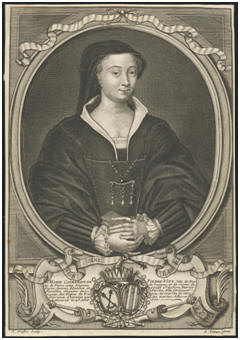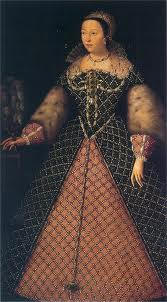Marie Catherine de Pierrevive

Marie Catherine de Pierrevive
Marie Catherine de Pierrevive was born at Lyons France (date uncertain) and died in 1570. She was the wife of Guidobaldo Antonio de Gondi who was the first member of the Gondi family to settle permanently in France. Her association with Catherine de Medici and her own personality and skills assisted the Gondi family in rising to positions of power and influence in sixteenth century France.
Engraving of Marie Catherine de Pierrevive
The engraving of Marie Catherine de Pierrevie(1) shown above right is by Claude Duflos (1700-1786). The copy of the engraving is provided by the National Library of Australia for use in this article. The script underneath the engraving is in French, and can be translated as: Marie Catherine de Pierre Vive Daughter of Nicolas de Pierre Vive, Seigneur de Lesigny, and of Janne de Turin, wife of Antoine de Gondi, second of the name, Florentine Patrician, Seigneur du Perron. She was Governess of the Children of France, and earned the title of heroic by her virtues. She died on August 4 1570.
There are two sets of arms that divide the script underneath the image. The description of each could be given in English as: at centre-left - Gondi arms - On a background of gold two battle maces, black in colour, saltire (set in the form of a St. Andrew's Cross) and tied with red (See Gondi Family); and at centre-right - Pierrevive arms – On a background of gold, three pales (pickets), red in colour, at the head of each a silver diamond.
Marie Catherine and Antoine de Gondi
Marie Catherine de Pierrevive was born to Nicolas de Pierrevive and Jeanne de Turin in Lyons, France, towards the end of the fifteenth century. Her date of birth is difficult to ascertain, and her date of death is given as August 4, 1570.
The Pierrevive, or Pietra Viva, family, came from Chieri in Piedmont, and settled in Lyons, France, around 1470. Like many Italian merchants and bankers, they settled close to the Place du Change where much of the city’s commercial activity was conducted. Between 1489 and 1492, four brothers from this rich family of grocers and apothecaries acquired a large property extending from the current Rue de Gadagne as far as the Montée Saint-Barthélémy, on which Boyssette House, an opulent mediaeval townhouse, stood. The Pierrevives demolished this house to undertake a huge building project across the whole of the property. The project included the building of commercial premises as well as their prestigious home known as “Belregard” situated at the highest point of their land.(2)
The four brothers who acquired the Boyssette House property were: Jean-Michel, chief physician to King Charles VIII, Amédée, an apothecary, a wealthy grocer merchant and tax collector for the King’s estates, and their two brothers Nicolas and André. The son of Amédée, Nicolas, who like his father was also a tax collector, became a city councillor in 1508, which led to his ennoblement. Nicolas’s three children also had illustrious lives. Charles became treasurer general to Francis I and general of land and finance to Catherine de Medici. Antoine was lord and baron of Vaulx en Lyonnais and ordinary butler to the King. Marie-Catherine, called Marion, who was born at what is now 14 Rue Gadagne (known from 1530 – 1640 as the Rue Pierrevive), was to marry into the Gondi Family.(3)
In 1516, Marie Catherine de Pierrevive married Guidobaldo Antonio de Gondi (1486-1560), who had come from Florence and settled in Lyons in 1506 as a member of the Florentine community of merchants and bankers who were established in the city. Guidobaldo, or Antonio(4) , as he became known, came to Lyons to look after already existing family business affairs. This was twenty years after the death of his father Antonio de Gondi (1443-1486) when all the members of the family who would inherit had attained their majority.(5)
In 1521, the Seignory of Le Perron was acquired – with Antonio (Guidobaldo) as Seigneur du Perron and Marie Catherine as Dame du Perron(6). The Seignory, which was run down, was located south of Lyons, and would have included a “feudal” house (Château du Grand Perron), some forested areas, lands, a list of those who paid dues, along with the right to apply and adjudicate middle and lower level justice in the small village of Perron. Antonio and Marie Catherine carried out some reconstruction of the Château. Included in the history of the Château du Grand Perron is also the history of the Château du Petit Perron. Both places were owned by the Gondi Family from 1621 to 1655. So began the Gondi ascendancy into the French nobility.
Marie Catherine as Salonnière
In the sixteenth century, Lyons was the major city on the route that linked Paris and Northern France to Italy. It was an international crossroads for commerce, printing, and the arts - these conditions encouraging the growth of what later became known as the salon society. And one of the most famous salons of Lyons was hosted by Marie Catherine de Pierrevive.(7) Recognised as being among the dames savantes of the time, Marie Catherine de Pierre-Vive made of her home in Lyons a “temple de la science et de l’esprit”, entertaining such luminaries as Marot, Dolet, Scève and Des Périers during the 1530s(8). Regarded as famous, hospitable and generous, she was an ardent patroness of letters and the arts, and her munificence was celebrated by the poet musician Eustorg de Beaulieu.(9)
The presence of women participating in the intellectual life of France during the sixteenth century coincides with the renewal of the Querelle des femmes in a literary quarrel called the Querelle des Amye. This skirmish had its beginnings in Lyons during the years that a number of women, including Madame de Pierrevive, as Marie Catherine was known, were active in Lyonnaise literary society.(10)
As the wife of Antonio de Gondi, and later as confidante of the Italian Catherine de Medici, Marie Catherine, by her influence and Italian background, no doubt potently encouraged in the women of Lyons that charm of wit, freedom and intellectual interest which gave them a resemblance to the Italian women of their time.(11)
Catherine de Medici and Marie Catherine

It was Catherine de Medici who determined the direction of much of Marie Catherine’s life after 1533. In that year, Catherine de Medici married Henry of Valois, Duke of Orleans, and second son of King Francis I and Queen Claude of France. Both Catherine and Henry were aged 14 at the time of their marriage which was intended to cement a Papal-French alliance. Three years later, when his brother Francis died, Henry became the Dauphin of France, and in 1547, King Henry II of France - with Catheriine his Queen Consort. Catherine de Medici came from Florence, where the lives of the Medici and Gondi were already interwoven. Catherine had had a turbulent upbringing, for a period being in fear of her life. Her marriage took place in Marseilles, and after the festivities, she and the French Royal Family made their way to Paris, stopping at Lyons on the way. It was not surprising, that, given the previous involvement of the Gondi family in Florence with the Medicis, and the Pierrevive’s involvement with royalty as described above, along with the position of Antonio and Marie Catherne de Gondi in the society of Lyons at the time, that Catherine de Medici came in contact with Marie Catherine de Gondi. Apparently in Lyons, Marie Catherine was extremely practical and advised Catherine de Medici on everything from pregnancy and child care to money matters.(12)
It was not till 1544 that Catherine de Medici gave birth to her first son Francis. Probably in the same year, Marie Catherine and Antonio de Gondi were called to Paris and were taken into service at the court of Catherine de Medici and her husband Henry. Marie Catherine became a lady-in-waiting to Mary Stuart (Queen of Scots) and was appointed "Gouvernante des Enfants de France" (Governess of the Royal Children) (13), a position which was later to include responsibility for the education of the future Charles IX and Henry III. Leonie Frieda, historian and biographer, tells us:
“Later, the Queen rewarded this remarkable woman and her family by giving her responsibility for her personal finances and she was made general administrator for her projects and building works, among other matters. In effect, Catherine chose Madame Gondi to be her treasurer, a highly unusual position for a woman in the sixteenth century. Most important of all, theirs was probably one of the few truly intimate friendships that Catherine (de Medici) ever enjoyed”.(14)
Antonio de Gondi was appointed the maître d’hotel for the Dauphin, and retained that position when Henry became King.
The Gondi Family in France
In more than forty years of marriage, Marie Catherine and Antonio de Gondi had ten children: Jean (Abbé of St Hilaire), Méraude, Anna (Religious at Florence), Albert (first Duke of Retz), Anne, Pierre (Bishop of Paris, Cardinal de Gondi), Charles, Jeanne (Religious at Poissy), Marie, and François (died young).
Throughout a greater part of the sixteenth and seventeenth centuries, the Gondi Family exercised much power in State and Church in France. With her own family background and wealth, personality and skills, Marie Catherine de Pierrevive, probably the First Madame de Gondi, played a significant role in what was to become an increasingly influential family.
REFERENCES
(1) The sources from which the material for this article is drawn variously refer to Marie Catherine de Pierrevive as Marie de Pierrevive, Marion de Pierrevive, Catherine de Pierrevive, Madame de Pierrevive, Dame de Perron, and Madame de Gondi (or Gondy). “Pierrevive” is sometimes spelled “Pierre-Vive”. The context makes it clear that it is the one person to whom reference is being made.
(2) “Grand Staircase and Renaissance Fireplace”, Remarkable Elements Room 6, Gadagne Musée, Lyons, France. Internet accessed August 3, 2010, through link Gadagne Museums.
(3) Ibid.
(4) Guidobaldo Antonio de Gondi became known as Antonio - after his father Antonio. He was also later, especially at court, known as Antoine de Gondy.
(5) Goldthwaite, Richard A., "Private Wealth in Renaissance Florence - a Study of Four Families", New Jersey: Princeton University Press, 1968, pp156-186.
(6) Cf “Guidobaldo Gondi”, Wikipedia, L’encyclopedia libera, http://it.wikipedia.org/wiki/Guidobaldo_Gondi , accessed August 3, 2010 This item implies that it was Marie Catherine who acquired the seigniory.
(7) Diana Robin, Anne R. Larsen, Carole Levin, Eds, “Literary Culture and Women”, Encyclopedia of Women in the Renaissance: Italy, France and England, ABC-CLIO England, 2007, p204. Internet accessed August 3, 2010, through link Google Books.
(8) Read, Kirk D., “Women of the French Renaissance in Search of Literary Community: A Prologomenon to Early Modern Women’s Participation in Letters”, Bates College. Internet accessed August 3, 2010, through link: http://tell.fll.purdue.edu/RLA-Archive/1993/French-html/Read,Kirk.htm.
(9) Ruutz-Rees, Caroline, “Charles de Sainte-Marthe 1512-1555”, BiblioBazaar (?), USA, 1918, p101. Internet accessed August 3, 2010 through link Google Books . Republished 2008. See also Google Read Books.
(10) Campbell, Julie, “Literary Circles and Gender in Early Modern Europe: A Cross-Cultural Approach”, Ashgate Publishing Co., England, 2006, p97. Internet accessed August 3, 2010, through link Google Books.
(11) Ruutz-Rees p101. Internet accessed August 3, 2010 through link Google Books.
(12) Frieda, Leonie, "Catherine de Medici", Orion Books, London, 2005, p88.
(13) In France at the time, this person, “la Gouvernante des enfants de France”, was usually drawn from the high nobility, and entrusted with the education of the royal couple’s children . She would perhaps be helped by assistant governesses.
(14) Frieda, p.88
WEB LINKS
Gondi Family, Vincentian Encyclopedia, October 2006
Claude Catherine de Clermont, Vincentian Encyclopedia, September 2010
Françoise Marguérite de Silly, Vincentian Encyclopedia, September 2010
